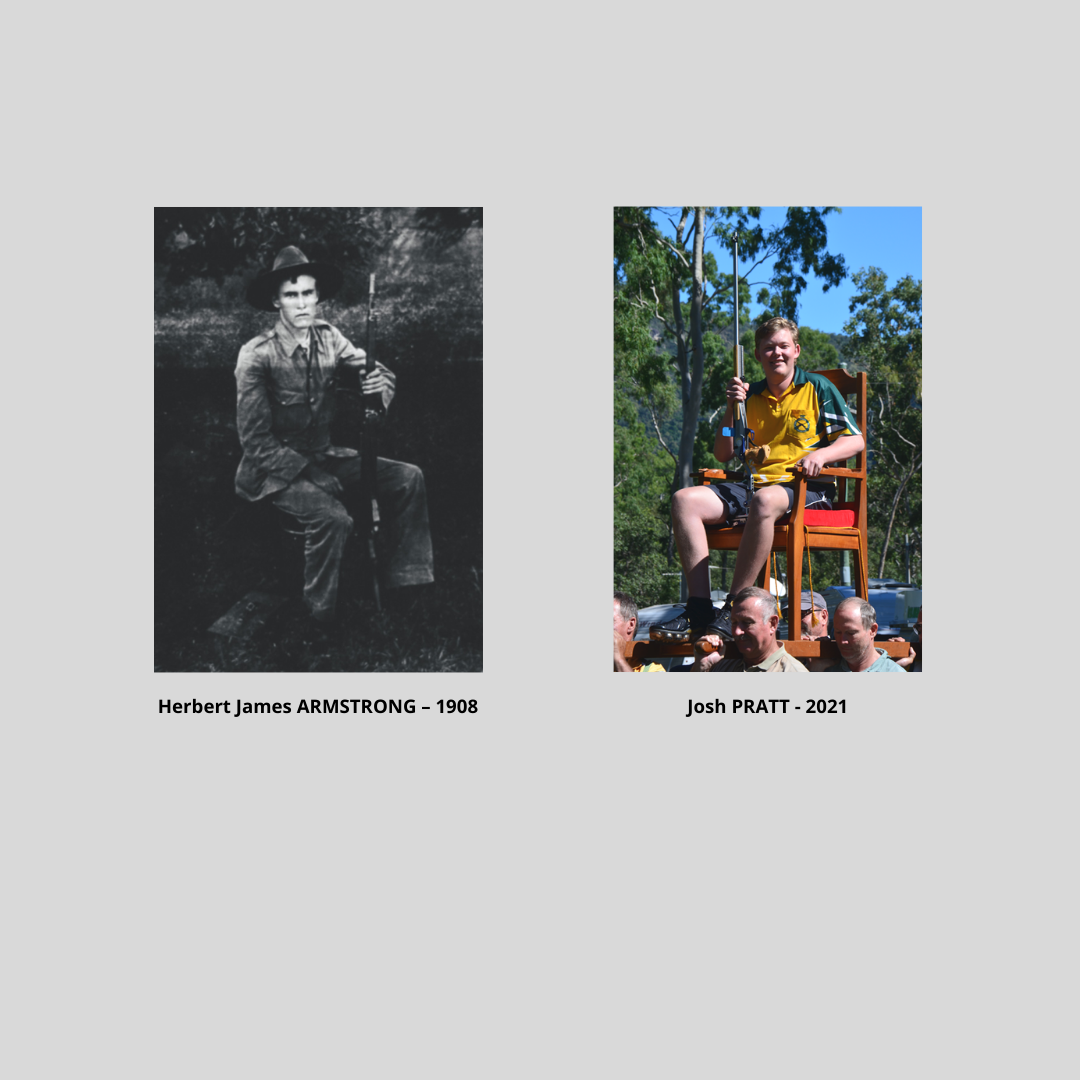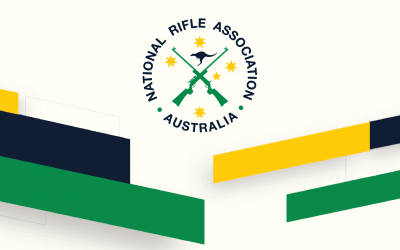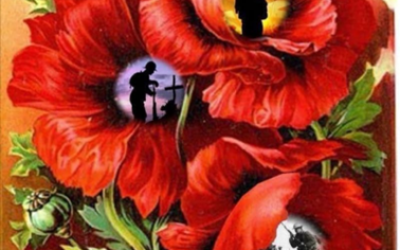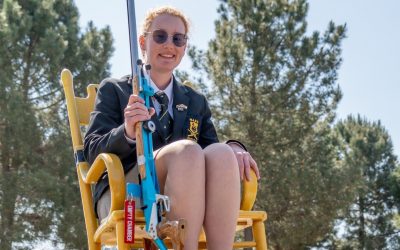BACKGROUND
Each time a young marksman or markswoman emerges as the champion of a Monarch’s Prize competition, the question uttered most – ‘Is today’s winner the youngest in our sport’s history?’. This question was asked again when Josh Pratt, a little over 18 years of age, from the Natives Rifle Club won the 2021 North Queensland Rifle Association’s (NQRA) Queen’s Prize on Sunday 16th May 2021. To date no one has been able to confidently answer this intriguing question.
This article attempts to identify some of Australia’s talented young rifle shooters who have risen to win one of our sport’s most prestigious competitions – the Monarch’s Prize. These competitors have been accorded the honour of being chaired, photographed and featured in the end of competition report but rarely has their age at the time of their momentous achievement been recorded.
It must be stated upfront that gaining accurate data about shooters who have since passed on is challenging. Data that has been published in this article has been verified with the individuals, where possible, and for those who have passed, evidence of their age has been sourced from newspaper reports identified via ‘Trove’, from State and Territory Associations where records still exist or other accessible official records. As a consequence, the list of names included in this article will certainly be incomplete but can be updated when additional evidence is identified.
LIST OF YOUNG WINNERS
To establish a broad picture and for the interest of the reader, a list of winners has been compiled to include as many of our successful shooters who were about 35 years of age or younger at the time of their achievement. Some well known names which our more senior members may recall as prominent young shooters in their day have also been included.
Two tabular versions of the list have been assembled. Table 1 is in year order of achievement and Table 2 is in order of age. The highlighted King’s/Queen’s Prize suggests that this person may be the youngest winner of that particular event.
Table 1
| YEAR | LOCATION | KINGS/QUEENS | WINNER | AGE |
| 1899 | Cludden RR, Townsville | NQRA Kings | Frederick Robinson | 25 years |
| 1903 | Dean RR, Adelaide | SARA Kings | LT Walter Addison | 29 years # |
| 1908 | Cludden RR, Townsville | NQRA Kings | Herbert Armstrong | 18 years 31 days |
| 1908 | Anzac RR, Toowong, Brisbane | QRA Kings | Stan Edwards | 25 years |
| 1908 | Randwick RR, Sydney | NSWRA Kings | Stan Edwards | 25 years |
| 1908 | Williamstown RR, Melbourne | VRA Kings | Stan Edwards | 25 years |
| 1910 | Cludden RR, Townsville | NQRA Kings | Tom Morphy | 24 years |
| 1913 | Randwick RR, Sydney | NSWRA Kings | David L McAlister | 27 years * |
| 1921 | Cludden RR, Townsville | NQRA Kings | Justin de Castres | 28 years |
| 1935 | Liverpool RR, Sydney | NSWRA Queens | Tom Ashton | 25 years ** |
| 1953 | Liverpool RR, Sydney | NSWRA Queens | Ken Lee | 24 years |
| 1955 | Cludden RR, Townsville | NQRA Queens | Glen Perrin | 24 years |
| 1956 | Cludden RR, Townsville | NQRA Queens | Geoff Abel | 22 years |
| 1968 | Pontville RR, Hobart | TRA Queens | Robin Braithwaite | 19 years ^ |
| 1974 | Pontville RR, Hobart | TRA Queens | Geoff Ayling | 35 years ## |
| 1974 | Swanbourne RR, Perth | WARA Queens | Libby Felton | 30 years *** |
| 1977 | Mt Vince RR, Mackay | NQRA Queens | Andrew Powell | 25 years |
| 1979 | Belmont RR, Brisbane | QRA Queens | Helen Griffiths | 32 years **** |
| 1982 | Swanbourne RR, Perth | WARA Queens | Barry Schlam | 21 years |
| 1985 | McIntosh RR, Canberra | NRAA Queens | James Corbett | 26 years ### |
| 1986 | Swanbourne RR, Perth | WARA Queens | Rick Scoones | 30 years |
| 1987 | Malabar RR, Sydney | NSWRA Queens | Mark Buchanan | 33 years ***** |
| 1989 | Malabar RR, Sydney | NSWRA Queens | Rob Rush | 34 years |
| 1990 | Mt Vince RR, Mackay | NQRA Queens | David Denman | 24 years |
| 1991 | Wellsford RR, Bendigo | VRA Queens | Geoff Grenfell | 30 years |
| 1991 | Malabar RR, Sydney | NSWRA Queens | Chris Wright | 32 years |
| 1992 | Malabar RR, Sydney | NSWRA Queens | Dale Heald | 25 years |
| 1993 | Dean RR, Adelaide | SARA Queens | Frank Pinyon | 24 years |
| 1994 | Malabar RR, Sydney | NSWRA Queens | Wendy Hadfield | 31 years |
| 1996 | Pontville RR, Hobart | TRA Queens | Andrew Halstead | 31 years |
| 1999 | Malabar RR, Sydney | NSWRA Queens | CPL Damien Brinin | 25 years |
| 1999 | Pontville RR, Hobart | TRA Queens | Warren Grenness | 28 years |
| 1999 | Belmont RR, Brisbane | QRA Queens | Steve Negus | 36 years |
| 2000 | Swanbourne RR, Perth | WARA Queens | Gray Robertson | 35 years |
| 2011 | Lower Light, South Australia | SARA Queens | Jake Stauwer | 27 years |
| 2014 | Wellsford RR, Bendigo | VRA Queens | Matthew Pozzebon | 23 years |
| 2016 | Lower Light, South Australia | SARA Queens | Rhyder Atkinson | 31 years |
| 2019 | Belmont RR, Brisbane | NRAA Queens | Alex Davies | 21 years |
| 2020 | Belmont RR, Brisbane | QRA Queens | Mitch Bailey | 22 years |
| 2021 | HRSC, Townsville | NQRA Queens | Josh Pratt | 18 years 49 days |
Table 2
| YEAR | LOCATION | KINGS/QUEENS | WINNER | AGE |
| 1908 | Cludden RR, Townsville | NQRA Kings | Herbert Armstrong | 18 years 31 days |
| 2021 | HRSC, Townsville | NQRA Queens | Josh Pratt | 18 years 49 days |
| 1968 | Pontville RR, Hobart | TRA Queens | Robin Braithwaite | 19 years ^ |
| 1982 | Swanbourne RR, Perth | WARA Queens | Barry Schlam | 21 years |
| 2019 | Belmont RR, Brisbane | NRAA Queens | Alex Davies | 21 years |
| 1956 | Cludden RR, Townsville | NQRA Queens | Geoff Abel | 22 years |
| 2020 | Belmont RR, Brisbane | QRA Queens | Mitch Bailey | 22 years |
| 2014 | Wellsford RR, Bendigo | VRA Queens | Matthew Pozzebon | 23 years |
| 1910 | Cludden RR, Townsville | NQRA Kings | Tom Morphy | 24 years |
| 1953 | Liverpool RR, Sydney | NSWRA Queens | Ken Lee | 24 years |
| 1955 | Cludden RR, Townsville | NQRA Queens | Glen Perrin | 24 years |
| 1990 | Mt Vince RR, Mackay | NQRA Queens | David Denman | 24 years |
| 1993 | Dean RR, Adelaide | SARA Queens | Frank Pinyon | 24 years |
| 1899 | Cludden RR, Townsville | NQRA Kings | Frederick Robinson | 25 years |
| 1908 | Anzac RR, Toowong, Brisbane | QRA Kings | Stan Edwards | 25 years |
| 1908 | Randwick RR, Sydney | NSWRA Kings | Stan Edwards | 25 years |
| 1908 | Williamstown RR, Melbourne | VRA Kings | Stan Edwards | 25 years |
| 1935 | Liverpool RR, Sydney | NSWRA Queens | Tom Ashton | 25 years ** |
| 1977 | Mt Vince RR, Mackay | NQRA Queens | Andrew Powell | 25 years |
| 1992 | Malabar RR, Sydney | NSWRA Queens | Dale Heald | 25 years |
| 1999 | Malabar RR, Sydney | NSWRA Queens | CPL Damien Brinin | 25 years |
| 1985 | McIntosh RR, Canberra | NRAA Queens | James Corbett | 26 years ### |
| 1913 | Randwick RR, Sydney | NSWRA Kings | David L McAlister | 27 years * |
| 2011 | Lower Light, South Australia | SARA Queens | Jake Stauwer | 27 years |
| 1921 | Cludden RR, Townsville | NQRA Kings | Justin de Castres | 28 years |
| 1999 | Pontville RR, Hobart | TRA Queens | Warren Grenness | 28 years |
| 1903 | Dean RR, Adelaide | SARA Kings | LT Walter Addison | 29 years # |
| 1974 | Swanbourne RR, Perth | WARA Queens | Libby Felton | 30 years *** |
| 1991 | Wellsford RR, Bendigo | VRA Queens | Geoff Grenfell | 30 years |
| 1986 | Swanbourne RR, Perth | WARA Queens | Rick Scoones | 30 years |
| 1996 | Pontville RR, Hobart | TRA Queens | Andrew Halstead | 31 years |
| 1994 | Malabar RR, Sydney | NSWRA Queens | Wendy Hadfield | 31 years |
| 2016 | Lower Light, South Australia | SARA Queens | Rhyder Atkinson | 31 years |
| 1991 | Malabar RR, Sydney | NSWRA Queens | Chris Wright | 32 years |
| 1979 | Belmont RR, Brisbane | QRA Queens | Helen Griffiths | 32 years **** |
| 1987 | Malabar RR, Sydney | NSWRA Queens | Mark Buchanan | 33 years ***** |
| 1989 | Malabar RR, Sydney | NSWRA Queens | Rob Rush | 34 years |
| 1974 | Pontville RR, Hobart | TRA Queens | Geoff Ayling | 35 years ## |
| 2000 | Swanbourne RR, Perth | WARA Queens | Gray Robertson | 35 years |
| 1999 | Belmont RR, Brisbane | QRA Queens | Steve Negus | 36 years |


Stan Edwards

The name Stan Edwards appears three times in the list in recognition of his extraordinary achievement of winning his first three King’s Prizes in the same year, 1908. Stan Edwards may be able to claim other intriguing records. At the 1905 NSW King’s Prize, Stan Edwards tied with Harry Motton who would later become Stan’s father-in-law. Stan was 22 years of age at the time and that would most likely make him the youngest Australian shooter to lose the Monarch’s Prize in a shoot-off. At the 1913 NSW King’s Prize, Stan Edwards, at 30 years of age, tied with Dave McAlister and again lost the shoot-off. At the 1920 SA King’s Prize, Stan Edwards found himself in yet another tie, this time with fellow 1919 Australian Team mate Harry White (Jnr) who lost the shoot-off.
Stan Edwards died in 1962 at 79 years of age. Harry Motton died 16 years earlier in 1946 and Harry White died in 1949. Sadly, Dave McAlister was killed during the Great War.
Commonwealth Countries
A brief overview of some of the other Commonwealth country young top shot’s achievements provides interesting reading and presents data to enable a broad comparison to be made.
NRAUK. Tony de Launay, the Curator for the Museum of the NRAGB advised that the youngest two UK Bisley Monarch’s Prize winners were Ensign Edward Ross in 1860, and Private Angus Cameron in 1866, both at the age of 19 years. Further research suggests Des Bourke was also aged 19 years when he won the Bisley King’s Prize in 1924. It is likely the youngest female to win Bisley is Joanna Hossack who in 2000 was 20 years of age.
DCRA. From records available within DCRA, it appears that the youngest winners of the Canadian Governor General’s Prize were Bob Pitcairn in 1962 and Pat Vamplew in 1977. Both competitors were 24 years of age when they won Canada’s most prestigious shooting event.
NRANZ. Diane Collings (nee Blaymires) might be the youngest competitor to claim victory in the NZ Ballinger Belt when, aged 21, she won the 1981 event. Diane also won the Belt in 1987 and 2014 and represented New Zealand at the 2002 Commonwealth Games winning the bronze medal in the individual match. Other young Kiwi winners were Percy Berry in 1930 aged 21 years, M.G. (Morrie) Gordon 1951 & 53, aged 24 and 26 years and Ross Geange 1995 & 97 aged 25 and 27 years. Of note Diane’s husband, Mike, might be able to claim being the oldest to win the Ballinger Belt at age 67 years when he won in 2022. Mike won the Belt previously in 1998 and 2021.
Zimbabwe. Gillian Webb-Enslin (nee Webb) is most likely the youngest winner of the Zimbabwean President’s Medal which she first won in 1989 at age 19 years. Gillian won the event a second time some years later. Of note, it was Gillian who converted husband Darren from being a hunter to a target rifle shooter.
Commonwealth Games. Des Vamplew, aged 22 years, won the individual gold medal and was crowned Commonwealth Champion after his success on home soil at the 1978 Commonwealth Games hosted by Edmonton, Alberta, Canada. Of note, Des’s brother Pat won the bronze medal in that same event. Des is the youngest shooter to win the Commonwealth Games fullbore individual match.
HERBERT JAMES ARMSTRONG
Herbert Armstrong won the NQRA King’s Prize on 10th April 1908. He was born on 10th March 1890 at Collingwood, Victoria. His father, James Herbert Armstrong, was an accountant working in Irvinebank, North Queensland. Young Herbert Armstrong’s success was possibly the most prestigious achievement for any resident of Irvinebank before the Great War and most likely afterwards.
The Townsville Daily Bulletin, 28th April 1908, page 7 reported on the return home, by train, to Irvinebank by the 1908 North Queensland Rifle Association King’s Prize winner, Herbert J. Armstrong, and his teams mates:

Armstrong’s War Service
Australia’s very first response when joining the other Empire countries at the outbreak of the Great War involved members of North Queensland Rifle Clubs who were directed to join the Australian Naval and Military Expeditionary Force (ANMEF) for deployment to Papua New Guinea. Australia’s participation in what might be described as the WW I New Guinea campaign came as the result of a British Government request. Germany had established wireless radio stations on islands in the Pacific allowing for direct contact with its powerful naval fleet and with headquarters in Berlin. Breaking Germany’s strategic communications network in the Pacific was critical, as was defending Australian territory.
On 4th August 1914, the Kennedy Regiment, which consisted of companies at Charters Towers, Townsville and Cairns was ordered to mobilize and proceed to its war station at the northern gateway of Australia. The Regiment required 386 men to raise it to war strength and 16 rifle clubs were instructed to provide this number between them. These clubs at once sent forward 474 medically fit members. The required 386 were selected from this number and embarked with this Regiment. The Irvinebank Club from an active strength of 115 sent 90 members, the Herberton Club with an effective strength of 44 sent 41, the Yungaburra Rifle Club also provided 47 members to this contingent and the remainder of the NQRA clubs sent the balance of 208 men required.
Herbert Armstrong, being a member of the Irvinebank Rifle Club, reinforced the Kennedy Regiment and became a member of the ANMEF. The rifle club members became a part of the group which was later called the ‘Dirty 500’.
Not deterred by his ANMEF experience, Herbert Armstrong joined the Australian Imperial Force on 11th March 1916 at age 26. His occupation was listed as Accountant. After his early training he was promoted to corporal and on arriving in France on 21st December 1916, as a reinforcement, was promoted to acting sergeant. He fought with the 42nd Battalion and was promoted to 2nd Lieutenant in August 1917 and shortly thereafter sustained a gun shot wound to his left shoulder which resulted in his evacuation to England. His Service Record suggest that he departed England with a fractured right elbow. Herbert Armstrong was deemed medically unfit for further service and was discharged in Australia in April 1918.
After the Great War

Herbert Armstrong’s name does not appear in any newspaper clippings featuring shooting results after his return to Australia in 1918. It is possible that the wound he sustained to his left arm coupled with his fractured right elbow may have sadly precluded him from further prone shooting.
Herbert Armstrong died on 8th April 1954 at 64 years of age and is buried in the Atherton Cemetery in North Queensland.
JOSH PRATT

Josh Pratt has just begun his shooting career and is very likley to add to his outstanding success of winning the 2021 NQRA Queen’s Prize. Josh has received considerable and welcomed support from his club, the Natives Rifle Club in Brisbane. Accomplished shooter and coach, Leigh Marett, will no doubt continue to guide Josh towards future achievements.
As a result of his 2021 Queen’s Prize win, Josh can claim the title of being the youngest Australian Queen’s Prize winner this century. He might also be able to claim several other honours:
- the youngest Australian Queen’s Prize winner,
- probably the youngest Australian Monarch’s Prize winner in the past 113 years, and
- probably the youngest QRA and Natives Rifle Club member to win an Australian Monarch’s Prize.
AUSTRALIA’S LADY QUEEN’S PRIZE WINNERS
At the outset our sport did not actively encourage ladies to compete in centerfire matches but did direct them towards the miniature rifle clubs. The rifle used by miniature rifle clubs was the Lee-Enfield rifle adapted to fire a .22 cartridge. Because the miniature rifles fired a smaller calibre and produced a much-reduced recoil, the miniature rifles were popular with our lady shooters.
Those ladies who wished to compete in fullbore matches were further discouraged by the Federal Government. The minutes of 13th October 1956 North Queensland Rifle Association (NQRA) Council Meeting held in Townsville, state:

This 1937 ruling by the Solicitor-General remained in place until the NRAA was granted self-administration by the Department of the Army in the early 1960s. It was only then that Australian ladies could participate freely in prize meetings including Queen’s Prizes. The list of Australian ladies who have won Queen’s Prizes is therefore relatively small.
| YEAR | LOCATION | QUEENS | WINNER |
| 1974 | Swanbourne RR, Perth | WARA Queens | Libby Felton + |
| 1979 | Belmont RR, Brisbane | QRA Queens | Helen Griffiths ++ |
| 1990 | Swanbourne RR, Perth | WARA Queens | Pat Gall |
| 1994 | Malabar RR, Sydney | NSWRA Queens | Wendy Hadfield |
| 1997 | Swanbourne RR, Perth | WARA Queens | Janet Wagland |
| 1999 | Wellsford RR, Bendigo | VRA Queens | Jenny Davies |
| 2019 | McIntosh RR, Canberra | ACTFBRA Queens | Donna Negus |


Reflecting upon women’s achievement in the sport of rifle shooting, Marjorie Elaine Foster (1893-1974) is a pioneer in that she joined the South London Rifle Club in the 1920s. This club was the only UK club that accepted women shooters at the time and obviously provided an environment whereby Marjorie’s talents grew. In 1930 Marjorie, at 37 years of age, became the first woman to win the Monarch’s Prize at Bisley. Australia’s first women to win a badge at Bisley was Miss Florrie Fergusson (Concord Rifle Club NSW) in 1938.
A YOUNG PRIZE MEETING WINNER
When Geoff Ayling was asked about his first Queens win, he remarked:

Few Australian marksman can claim an equivalent win at such a young age.
CONCLUSION
As stated at the beginning, this article attempts to identify some of Australia’s talented young rifle shooters who have risen to win one of our sport’s most prestigious competitions – the Monarch’s Prize. Gaining accurate data about shooters who have since passed on was challenging and often difficult to independently verify. Numerous shooters on the lists were personally contacted to ensure their details were correct.
The author has used his international contacts to gather the data as it relates to the various Commonwealth countries listed.
As National, State and Territory Association shooting records are scattered, if recorded or stored at all, the lists included in this article will certainly be incomplete. As this article appears to be the first attempt to gather, record and publish such data, it should be viewed as a work-in-progress to be updated when additional evidence is presented. The author welcomes any information the reader wishes to provide to enhance or add to the Australian Monanch’s Prize winners list.
At the time of publication, it appears that Herbert James Armstrong from the Irvinebank Rifle Club, having won the 1908 NQRA Kings at the age of 18 years and 31 days, is Australia’s youngest Monarch’s Prize winner.
Author’s Acknowledgement
I wish to acknowledge the information, gathered over the past eight months, which has been so willingly provided by the many shooters who are named in the list from 1974 onwards. The confirmation of ages by those competitors has given me great comfort as to the accuracy of this article. Additionally, I wish to thank the various State and Territory Association offices and rifle club members for their assistance.
Information contained within this article has been gathered from:

Author: Bruce A R Scott, President, National Rifle Association of Australia, 17 February 2022




